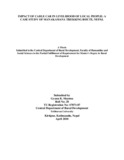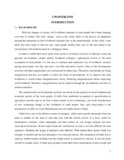Please use this identifier to cite or link to this item:
https://elibrary.tucl.edu.np/handle/123456789/3631| Title: | Impact of Cable Car Inlivelihood of Local People:A case Study of manakamana Trekking Route, Nepal |
| Authors: | Sharma, Gyanu K. |
| Keywords: | Tourism;Socio-economic |
| Issue Date: | 2010 |
| Publisher: | Department of Rural Development |
| Institute Name: | Central Department of Rural Development |
| Level: | Masters |
| Abstract: | This study has analysed several impacts of Manakamana cable car on the livelihood strategy ofthe local people of Manakamana-Aambukhaireni trekking route and its vicinity after the cablecar construction.Directly or indirectly, local people hadadopted several tourism activities tosustain their livelihood. But, when MCCestablished in 1998, in thisold so called trekking routetourists and pilgrims became less. Gradually,all the tourism activities of old trekking routecollapsed and the place became isolated and deserted. They have been forced and compelled toreturntoone and only agricultural activity, which was their old livelihood strategy. Before the construction of MCC, in Manakamana, Aambukhaireni trekking route, largenumbers of local people performed the activities like agriculture, animal husbandry, wagelabour, horticulture etc. but they were almost tourism oriented. After the construction of MCC,these sorts of activities have been reduced significantly. The production of major crops andbusiness activities has been reduced after the construction of MCC. The major causes are lowinvestment in agriculture and decline in tourism related activities. Likewise, the numbers of major domestic animal as well as their production have beenreduced after the construction of MCC. Similarly, fruit production has been declined andwhatever the local people would produce it would not get the proper market and reasonableprice.Employment opportunities for the local people in the hotel, lodge, restaurant, teashop,souvenir shop etc. were also missing due to the MCC. MCC had made an agreement with localpeople to give high priority in employment. But, only five local personals have got the job inMCC. Those who were involved in tourism-oriented activities like porter, businessman, touristguide, handicraft maker and seller, fruit seller etc. have lost their employment opportunities andtheir livelihood options were totally collapsed. MCC has brought social conflicts and evils in thestudy area with the increasing number of tourist. MCC is abeautiful example of modern technology. It is very popular, wide spread, wellaccepted as well as suitable means of transportation for a country like Nepal. Obviously, MCChas a great support and contribution for the economic development of nation as well as the localarea. But, sometimes modern technologycanhave negative impacts and the people will have tosuffer. MCC is a very good and suitable example of modern technology that has brought severalnegative impacts to local marginalized and poor of Manakamana-Aambukhaireni trekking routeand its vicinity. |
| URI: | http://elibrary.tucl.edu.np/handle/123456789/3631 |
| Appears in Collections: | Rural Development |
Files in This Item:
| File | Description | Size | Format | |
|---|---|---|---|---|
| COVER.pdf | 30.75 kB | Adobe PDF |  View/Open | |
| CHAPTER.pdf | 705.65 kB | Adobe PDF |  View/Open |
Items in DSpace are protected by copyright, with all rights reserved, unless otherwise indicated.
